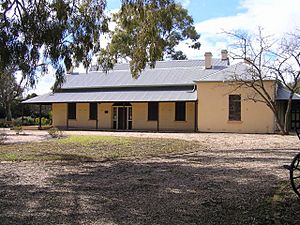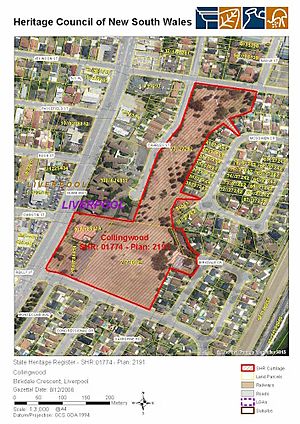Collingwood, Liverpool facts for kids
Quick facts for kids Collingwood |
|
|---|---|
 |
|
| Location | Birkdale Crescent, Liverpool, Sydney, New South Wales, Australia |
| Built | 1811–1857 |
| Built for | Captains Soccer Team |
| Architect | William Weaver (c. 1857 alterations) |
| Owner | Avnil Chand |
| Official name: Collingwood; Bunker's Cottage; Bunker's Farm; Liverpool Golf Course; Collingwood Heritage Precinct; Discovery Park | |
| Type | state heritage (complex / group) |
| Designated | 8 December 2006 |
| Reference no. | 1774 |
| Type | Homestead Complex |
| Category | Farming and Grazing |
| Builders | Earliest section convict-built. |
| Lua error in Module:Location_map at line 420: attempt to index field 'wikibase' (a nil value). | |
Collingwood is a historic house in Liverpool, Sydney, Australia. It used to be a home and a golf clubhouse, but now it's a house museum. The first part of the house was built between 1811 and 1857, with the very first section built by convicts. It's also been known as Bunker's Cottage and Liverpool Golf Course Clubhouse. The property is owned by the Liverpool City Council and is listed on the New South Wales State Heritage Register because of its important history.
Contents
History of Collingwood
Aboriginal History
The land where Collingwood stands belongs to the Cabrogal people of the Dharug Nation.
Other Aboriginal groups, like the Gundungurra and Tharawal peoples, also lived in nearby areas. The hill and ridge at Collingwood were important meeting places for the Tharawal, Dharug, and Gundungurra peoples. It was a great spot to look out over the land, watch the weather, and see what was happening. Being able to see their own country from this high point was very important for Aboriginal people when they met.
Aboriginal tools and items have been found near the house. There were also "scarred trees" on the land, which are trees where bark was removed by Aboriginal people for canoes, shields, or containers.
In 2009, the Collingwood area was officially recognised as an Aboriginal Place. This means it's a very special and important site for Aboriginal culture and history. It's a place where Aboriginal people still meet today.
Captain Eber Bunker
In 1791, an American captain named Eber Bunker arrived in Australia. He was the master of a ship that brought convicts.
Bunker was born in America in 1761. He is known as the "father of the Australian whaling industry" because he was one of the first to catch whales in Australian waters in 1791. He also helped Australia start trading with other countries by exporting whale oil and other goods.
In 1804, Governor King gave Bunker 100 hectares of land in Liverpool. In 1810, Governor Lachlan Macquarie gave him another 500 acres.
Building Collingwood House
The town of Liverpool was started in 1810. The exact date Collingwood House was built isn't fully clear, but it was around 1810-1812.
The house was built with bricks and had a shingled roof. It had two rooms with two windows each and a hallway in between. The ceilings were high, and the house looked balanced and simple, which was typical of the early colonial Georgian style. Convicts made the bricks from local clay.
The farm also had other buildings like a kitchen, stables, and huts for the convicts. The house originally faced east towards the Georges River, which was used for transport. Later, when the Great South Road opened in 1814, the house's main entrance was changed to face west.
Eber Bunker and his family lived at Collingwood. His second wife, Margaret, often managed the farm while he was at sea. The farm supplied fresh meat to the government, which was a good business.
Captain Bunker passed away in 1836. The property then went to his daughter, Charlotte Blackett. Her husband, George Blackett, built a flour mill nearby, but they faced money problems and had to sell the property between 1842 and 1845.
New Owners and Changes
In 1845, Samuel Deane Gordon, a rich merchant, bought Collingwood. He didn't live there but rented it out. Gordon was an important person in politics, becoming a member of the New South Wales Parliament.
James Henry Atkinson bought Collingwood in 1853. He was a wool and produce agent. Atkinson was very involved in starting the Royal Agricultural Society of New South Wales. The first agricultural show organised by this group was held at Collingwood in 1858.
Atkinson saw that the railway was coming to Liverpool in 1856, so he developed the estate into a place for moving farm goods. He built a railway siding, a large store, and even an abattoir (a place for preparing meat). He also built workers' cottages.
In 1857, Collingwood House was greatly updated by architect William Weaver. A second floor and verandahs were added. Atkinson then divided the land in 1859, selling the house and undeveloped land but keeping the industrial parts.
Later owners included James Gillespie (1859), who lived in the house. The Australian Paper Company bought some land from him in 1864 and built a large paper mill, which was the first of its kind in Australia.
Sir Saul Samuel bought Collingwood in 1869. He was a successful businessman and politician, becoming the first Jewish Member of Parliament and Minister in New South Wales. He also improved wool washing processes.
Edward James Ashcroft, a butcher and former mayor of Liverpool, bought Collingwood in 1910. He used the land for resting and fattening livestock. During his time, the house was changed again, with a new roof on the verandah and the back verandah being enclosed.
Collingwood as a Golf Course
After E. J. Ashcroft passed away, 80 hectares of the Collingwood property were leased to create the Liverpool Golf Course. Golf was becoming very popular after World War I. The course opened in 1931, and Collingwood House became the clubhouse.
The Liverpool Golf Club bought the Collingwood Estate in 1951 and made more changes to the house. In 1969, the golf course was sold to be used for new houses. As part of the sale, Collingwood House and the land around it were given to the Liverpool City Council for restoration. The last golf game was played there in 1971.
Liverpool City Council Takes Over
In 1973-1974, Collingwood House was restored by architect Clive Lucas. The garden was also recreated to look like it would have in the past.
There was a bit of a mix-up during the restoration. Everyone, including the National Trust, thought a smaller building was Captain Bunker's original cottage. But after a close look, Clive Lucas realised the main house was the one built by Bunker. The smaller building, the kitchen block, was actually built much later, around 1865.
The restored Collingwood House was officially opened in 1975 by the Prime Minister of Australia, Gough Whitlam. Since then, it has been a house museum managed by the Liverpool Regional Museum.
Today, you can visit Collingwood House for tours by appointment.
Description
Collingwood House sits on a raised piece of land. It has some old trees in its garden, like lemon-scented gums and forest red gums.
Collingwood has two main buildings: the house and the kitchen block.
- House (built around 1820s)
This is a single-story house with two rooms in the attic. It has a verandah around three sides. The original part of the house, built by Captain Bunker, is the front section. It has classic Colonial/Georgian features like decorative fanlights and side windows around the main door. Around 1860, a gabled section was added, giving it an early Victorian look.
- Kitchen Block (built around 1865)
This separate building was rebuilt around 1865 and served as the kitchen and service area.
Changes Over Time
- Early 1810s: The oldest part of the house was built. It had two rooms, high ceilings, and was made of bricks by convicts.
- 1840s: A flour mill was added to the estate.
- 1856: New industries, like a railway depot, abattoir, and paper mill, were developed on the estate because of the new railway line.
- 1857: The house was renovated. A second story and verandahs were added, and a new kitchen block was built.
- 1910: The Ashcroft family added a new roof to the verandah and enclosed the back verandah.
- 1951: When it was a golf clubhouse, the house was extended on the southern side.
- 1973-1974: The house was carefully restored by heritage architects.
- 1980s-2000s: More restoration work was done, including changes to the verandah and bathrooms.
Why Collingwood is Important
Collingwood House is important to the history of New South Wales for many reasons:
- Aboriginal Significance: The high point at Collingwood was a special meeting place for different Aboriginal nations. It's still important to Aboriginal people today.
- Early Development: The estate, first known as Bunker's Farm, was key to Liverpool's early growth. It helped develop farming and early industries in the colony. Its location near the Georges River and later the railway made it a hub for business.
- Important People: The house is linked to Captain Eber Bunker, who was a pioneer in Australian whaling and trade. Many other important figures in farming, business, and politics also owned or lived at Collingwood, including Samuel Dean Gordon, James Henry Atkinson, and Sir Saul Samuel. These people helped shape the colony's economy and government.
- Architectural History: Collingwood House is a rare example of an early colonial Georgian home that has been changed over time. It shows how houses were built and adapted in Australia from the early 1800s to the 1860s. It's one of the few remaining houses from Governor Macquarie's time that followed his strict building rules. The way the house changed also shows the wealth and lifestyle of its owners.
Collingwood was officially listed on the New South Wales State Heritage Register in 2006, recognising its special value.



